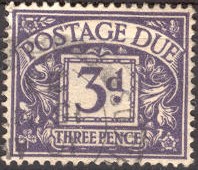

Return To Catalogue - Great Britain
Note: on my website many of the
pictures can not be seen! They are of course present in the cd's;
contact me if you want to purchase them: evert@klaseboer.com.
1/2 p green 1/2 p orange (1951?) 1 p red 1 p blue (1951?) 1 1/2 p brown (1923) 1 1/2 p green (1951?) 2 p brown 2 p black (1955) 3 p violet (1918) 4 p green (1921) 4 p blue (1951?) 5 p brown 1 Sh blue (1915) 1 Sh light brown (1951?) 2 Sh 6 p brown on yellow (1938, inscription 'TO PAY') 5 Sh red on yellow (1955? inscription 'TO PAY')
These stamps have perforation 14 and watermark 'Crown GvR' (2 types). A postage due stamp of 2/6 brown on yellow with inscription 'TO PAY' was issued later.
Value of the stamps |
|||
vc = very common c = common * = not so common ** = uncommon |
*** = very uncommon R = rare RR = very rare RRR = extremely rare |
||
| Value | Unused | Used | Remarks |
Cheapest type |
|||
| 1/2 p | c | c | |
| 1 p | * | c | |
| 1 1/2 p | * | * | |
| 2 p | * | c | |
| 3 p | * | c | |
| 4 p | * | c | |
| 5 p | ** | * | |
| 1 Sh | *** | c | |
Several countries used the above postage due stamps overprinted, for example Southern Rhodesia (with overprint "SOUTHERN RHODESIA") or Bechuanaland (overprint "BECHUANALAND PROTECTORATE", see image below).
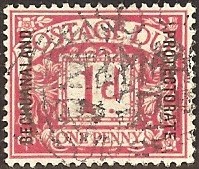
The values 1/2 p green, 1 p red, 2 p black, 3 p violet and 1 Sh blue exist with overprint "M.E.F." (Middle East Forces, 1947?). I've seen all values with a large "RHODES 31.3.47 DODECANESE" cancel, which is probably a cancel made through philatelic influence.
Some values also exist with overprint "B.M.A. ERITREA" (surcharged in "CENTS") or "B.A. TRIPOLITANIA" (surcharged in "M.A.L.").
1/2 p red (plate 5) 1 p brown (plates 1 to 3) 3 p red (plates 1 to 5) 4 p green (plate 1) 6 p grey (plates 1 or 2) 1 Sh green (plates 1 to 10) 1 Sh brown (plates 10 or 12) 3 Sh blue (plate 1) 5 Sh red (plate 1 to 3) 10 Sh grey 1 Pound brown 5 Pounds orange
The 5 Pounds stamp was printed in 14 rows of 4 stamps each with the following corner letters (the same setting was also used for the postage stamp of 5 Pound, but there the sheet was divided into two parts):
| A A | B A | C A | D A |
| A B | B B | C B | D B |
| A C | B C | C C | D C |
| A D | B D | C D | D D |
| A E | B E | C E | D E |
| A F | B F | C F | D F |
| A G | B G | C G | D G |
| A H | B H | C H | D H |
| A I | B I | C I | D I |
| A J | B J | C J | D J |
| A K | B K | C K | D K |
| A L | B L | C L | D L |
| A M | B M | C M | D M |
| A N | B N | C N | D N |
I've been told that the above forgery was made by Peter Winter in the 1980's. I've seen this forgery with cancel "LUDLOW MY 9 1894". The letters in the bottom corners are "D" and "O", which do not exist in genuine stamps in this combination.
The Barefoot guide of forgeries of Great Britain mentions another forgery that was produced in the 1970's with corner letters "HQ" (impossible for genuine stamps) and with cancel "7A EDINBURGH AP 16 80".
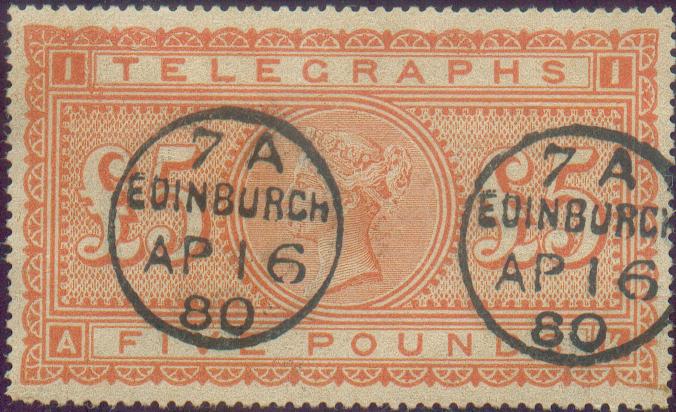
A similar forgery, but with corner letters "AK".
According to the Barefoot guide, the perforation in the corners
is not correct and the perforation holes are too small.
There exist also some fiscal stamps with overprint "MILITARY TELEGRAPHS" (they seem to have been used in Great Britain, Egypt, Bechuanaland and South Africa), examples for Egypt (Sudan?):
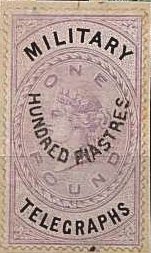
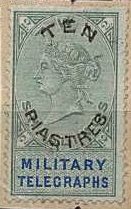
(Reduced sizes)
All these stamps are very rare.
Some similar stamps with overprint "ARMY TELEGRAPHS" also exist, they were issued in 1895 (1/2 p orange) and 1900 (1/2 p green, used in South Africa).
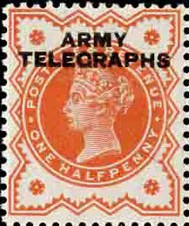
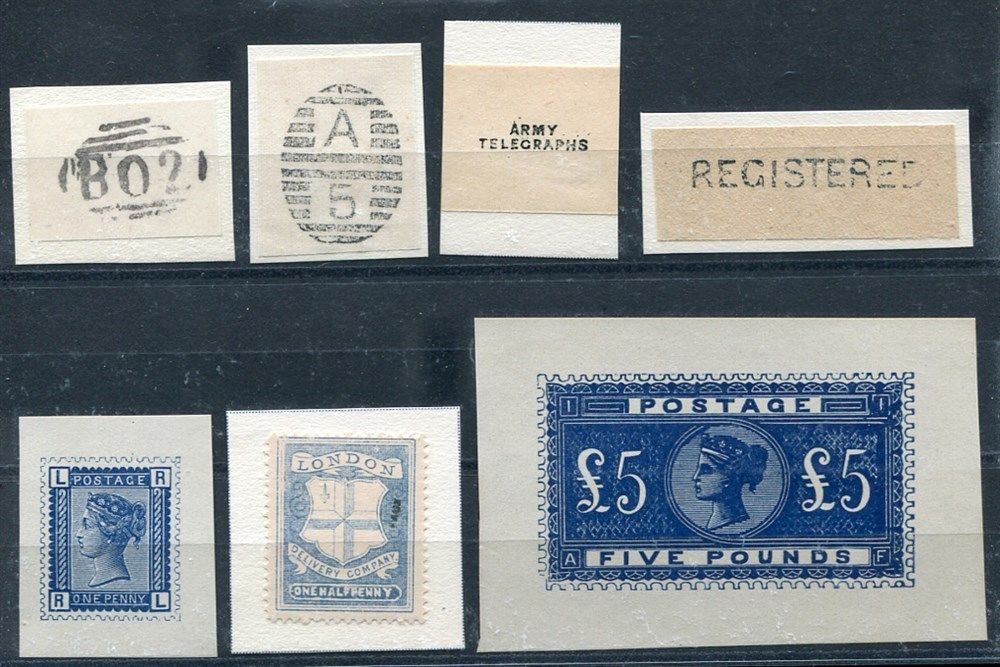
This overprint has been forged. Here some forgeries and forged
overprints made by the forger Fournier.
This company issued many telegraph stamps, (the first ones in 1851).

(Universal Private Telegraph Company, I've also seen a 6 p brown)
This telegraph company issued its stamps in 1864 in the values: 3 p (?), 6 p brown, 9 p (?) and 1 Sh lilac. In some (all?) cases they have a control number overprint in various colors (red, black, green, orange).
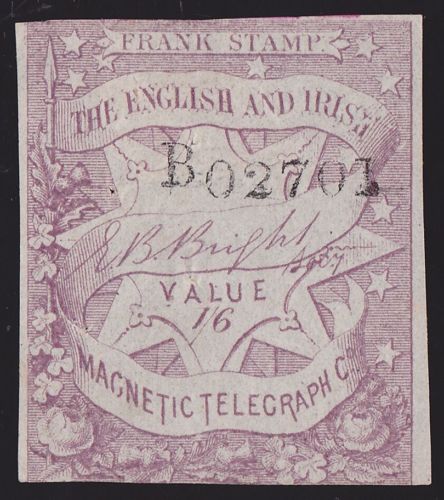
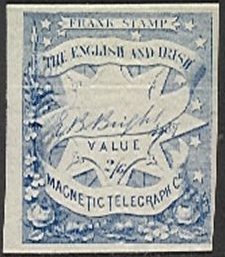
(English and Irish Magnetic Telegraph)
The English and Irish Magnetic Telegraph stamps were issued in 1853 in the values: 1 Sh black, 1 Sh 6 p lilac, 2 Sh 6 p blue, 4 Sh red and 5 Sh green. There should be a control letter on these stamps. Stamps without control letter (such as the above 2Sh 6 p) are remainders.
The British and Irish Magnetic Telegraph Company also issued stamps in 1857. I've seen: 3 p, 6 p and 1 Sh, 3 Sh, 5 Sh; all in black (other values might exist).
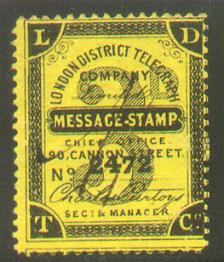
(London District Telegraph Message Stamp 90 Cannon Street)
The London District Telegraph Company issued its stamps in 1862 in the values: 3 p black on yellow, 4 p black on blue and 6 p black on red and 6 p red. These stamps have control numbers overprinted (in red, small black and large black, depending on the value).
I've also seen 'Bonelli's Electric Telegraph Co Limited' with a mercury design (3 p grey, 3 p brown, 3 p green, 6 p black, 9 p blue and 1 Sh orange) issued in 1861.
Issued stamps in 1860. Sorry, no picture available yet
Issued first stamps in 1862 in upright size: 3 p brown, 6 p red and 1 Sh violet. Sorry, no picture available yet.
Another set was issued in 1863 (oblong size):

(United Kingdom Electric Telegraph Company Limited, 'INT'
overprint)
The following values exist: 3 p yellow, 6 p red, 1 Sh violet, 1 Sh 6 p green, 2 Sh brown (the values 3 p, 6 p and 1 Sh also exist overprinted with 'INT').
(Sorry, no picture available yet)
Issued stamps in 1861: 4 1/2 p lilac, 3 Sh 9 p lilac, 4 Sh lilac, 7 Sh 6 p lilac, 8 Sh lilac and 4 Sh (in red) on 8 Sh lilac. Proofs in black seem to exist.
1 p black 3 p red 4 p blue 6 p green 1 Sh brown
These stamps have perforation 12.
Value of the stamps |
|||
vc = very common c = common * = not so common ** = uncommon |
*** = very uncommon R = rare RR = very rare RRR = extremely rare |
||
| Value | Unused | Used | Remarks |
| 1 p | * | ** | |
| 3 p | * | ** | |
| 4 p | * | ** | |
| 6 p | *** | *** | |
| 1 Sh | * | ** | |
A special delivery service existed to transport the mail between each of the colleges in Oxford and Cambridge from 1870 to 1886. Stamps, envelopes and postcards were issued. Keble college started using stamps first in 1870. The use of stamps was prohibited by the government in 1886, but postal stationery still seems to have been used afterwards.
Examples of stamps:
OXFORD: 'All Souls', 'Balliol', 'Exeter', 'Hertford', 'Keble',
'Lincoln', 'Merton', 'St.John's';
CAMBRIDGE: 'Queen's', 'St.John's' and 'Selwyn'.
Examples of envelopes:
'Hertford', 'Keble' and 'Merton'
Examples of postcards:
'Exeter', 'Hertford', 'Keble' and 'Merton'
Examples:
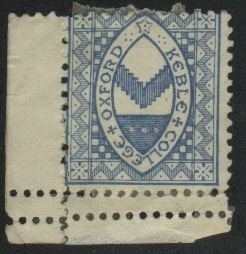
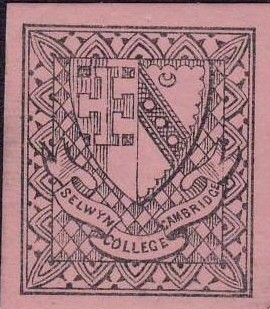
Keble College (Oxfored) and Selwyn College (Cambridge, 1882)
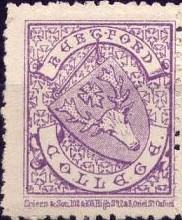
Hertford College (1875)
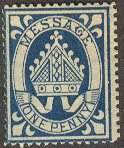

Lincoln college 1877 (Oxford), and St.John's coll. messenger
(1883), reduced sizes
Literature:
"The College Stamps of Oxford and Cambridge, A Study of
Their History and Use from 1870 to 1886", by
Cummings (1904), 109 p.
"Hurt & Williams"
Newspaper tax marks started to be used in 1712 and can be found up to 1855.
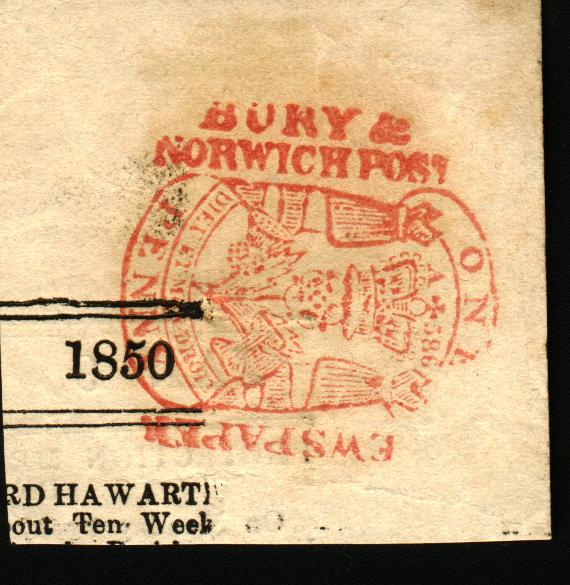
Bury and Norwich post about 1850
North British Advertiser Newspaper One Penny:
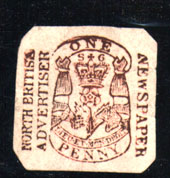
(Reduced size)
I have seen a similar design for 'Montrose Review Newspaper', 'Illustrated London News Newspaper' and 'London Gazette Newspaper' (all 1 p red).
Other design:

(Illustrated London News Newspaper)
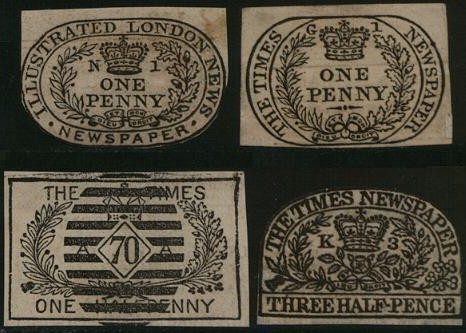
('Illustrated London Newspaper, The Times (3x))

Genuine?
13 different values exist, 1 value overprinted "On Service" and 2 overprinted "DUE". Some of these stamps can be considered as bogus issues.
With value straight, "EXPRESS DELIVERY" second line from top
1/3 p black (three types)
Surcharged
'1/3 d' (light blue) in a circle on 1/3 p black
'1/2 d'(black) in a circle on 1/3 p green
'1 d' (red) in a circle on 1/3 p black
Overprinted "DUE" diagonally
1/3 p black ("DUE" in blue)
With value in circle, "EXPRESS DELIVERY" at the bottom
1/4 p green and black
1/3 p grey and red
1/2 p light blue and blue
3/4 p blue and black
1 p red and violet
1 1/2 p violet and black
2 p grey and violet
2 1/2 p blue and red
3 p red and black
Overprinted "DUE" diagonally
1/2 p red ("DUE" in blue, value in cirle in red as well)
1/2 p red and blue ("DUE" in blue)
Overprinted "On Service" in light blue
- p violet (no value inscription, star in center)
If my information is correct, the 'genuine' stamps have perforation 11 1/2. Some forgeries were made in 1925 with perforation 10 1/2. The design is almost perfect. If anybody has a picture of a guaranteed genuine stamp, please contact me! Another more primitive forgery also exists (with differs in lettering etc.). More information on forgeries of Ruhleben can be found at: http://www.filatelia.fi/forgeries/ruhleben.html.
Even postal stationery seems to have been issued (1/3 p black only), example:
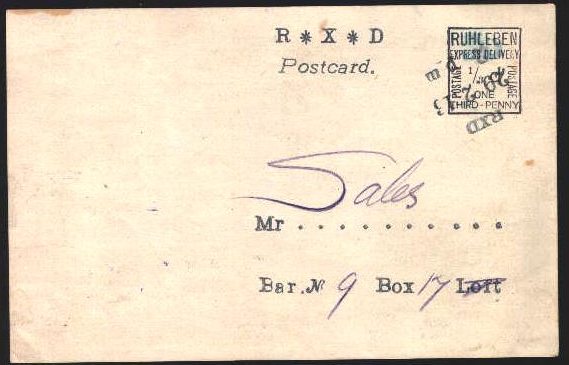
(Reduced size)
This postcard ios also known to be forged.
A 'Letter-card' also exists:3/4 p blue and black.
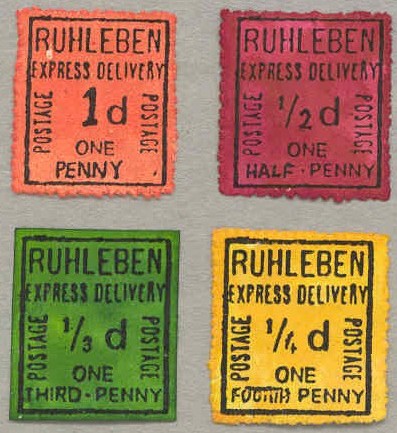
(Some mystery stamps, black on coloured paper, proofs or
forgeries? Images obtained thanks to Mark Curtis)

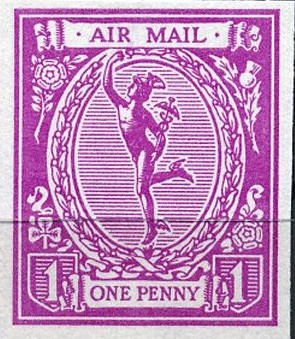
Inscription "AIRMAIL ONE PENNY", standing Mercury in an
ellipse, the imperforate stamp at the right is probably a forgery
of this essay.
I have seen identical perforated stamps in the same value (1 p) in the colours red, green, brown, orange, blue and violet. Apparently these are essays made in 1923.
Dealer label of Stafford-Smith and Smith in Bath with the portrait of Queen Victoria, probably issued somewhere between 1866 and 1880. More information on these dealers can be found at: http://www.ukphilately.org.uk/bpt/whowaswho/whowaswho-s.htm under 'Smith'.